Endurance Events and Lactate Testing
With Emphasis on the Triathlon
12 of 19
The primary use of lactate testing is to
assess performance over time
Is the Training Working?
The primary use for lactate testing is to assess performance over time. In other words:
- is the athlete progressing?
- is the training that is being used working?
Whatever training recommendations the athlete is using, they can be evaluated by lactate testing over time. Many of the training recommendations we have in our triathlon document are less intense than those recommended by others. So who is right?
There will never be general agreement on who is the best coach. But it is important that whatever is being recommended and executed is working. The less intense overall training is based on a particular philosophy of training. One does not have to subscribe to this training philosophy in order to use lactate testing effectively. Let’s contrast two different styles of training.
One is what we call the High/Low and the other is the Rocky philosophy. High/Low says that most of the volume will be at low intensity levels - regeneration or only slightly faster at what some coaches call “extensive”. When the athlete does train at higher intensities, small volumes of very high intensities are often best. Most of the training will be at low levels determined by the V4 test.
A contrasting philosophy is what we call "The Rocky philosophy" (from the movie Rocky in the 1970’s.) and is based on the concept that the higher the intensity the better and the more you do, the more your muscles will respond and the faster the athlete gets. There are a multitude of other training philosophies and the typical triathlete is familiar with many of them.
There is a masterful new article in the journal Sportscience (13, 32-53, 2009) by Stephen Seiler and Espen Tønnessen, entitled "Intervals, Thresholds, and Long Slow Distance: the Role of Intensity and Duration in Endurance Training." This article draws from many studies, and from detailed observation of the actual training practices of highly successful athletes in many disciplines. There have been few experiments with athletes that are already highly trained, because truly elite athletes are usually unwilling to risk a change in their training that may impair their performance for an important competition.
They found that, almost without exception, athletes that succeed best in endurance events spend most (75-85%) of their training days at low intensity (lactate levels below 2 mmol/l, at 50-65% VO2max), a small percentage at high intensity (short intervals with lactate above 6.0 mmol/l, at 90%-100% VO2max), and practically none anywhere near "lactate threshold." As athletes become more elite, and as they get closer to competition, the total volume of training often increases, with the intense workouts becoming more intense, and the easy workouts often becoming easier. But the overall proportion remains the same.
For many elite athletes, lactate testing is used, not only to monitor the results of training, but to calibrate training paces. Athletes often feel that low-intensity workouts are TOO easy, and must be a waste of their time. The better-trained the athletes, the better they will feel near their VO2max, and the more harm it will do if they train very much at this level. Usually these paces are expressed as a percentage of V4 speed (or power), and often heart rates are used as a practical field measurement of pace.
This same article reported an experiment by Esteve-Lanao with recreational runners comparing 2 matched groups using different intensity proportions:

This demonstrates the tendency of recreational athletes to train much too hard on the easy days and much too easy on the hard days. Since their training time is quite limited, they tend to go as fast as they can for as long as they train. And they often are not able to complete really intense training. Still these groups trained significantly differently. And the results were different: the Hi/Lo group improved their times significantly more at both 7 and 11 weeks than did the other group.
Not all studies show a significant advantage for Hi/Lo, but those that show a difference are in favor of the Hi/Lo general pattern.
Lactate testing is appropriate for any training philosophy. That is because lactate testing’s main function is to assess the training that has been done. If your training is working, the lactate test is the best report card to verify that it is working. Similarly, if your training is not working, the lactate test will show that. It is important to separate the lactate test from training. Lactate tests do help you train better, but mainly by helping each athlete find what works best for him or her. Here are two charts that assess the effects of training over time.
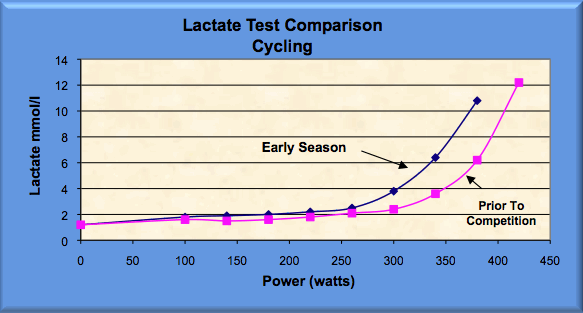
The above chart suggests that the training for this athlete has been very effective. The charts indicate that the aerobic capacity of this athlete has improved substantially over the two periods. These two readings were about 3 months apart and probably one more test should have been conducted between the two tests. Also the second test used 9 separate stages plus a resting lactate. The first four of these stages were probably unnecessary. Let’s look at the following set of tests done for a good female triathlete and using only a three step test.
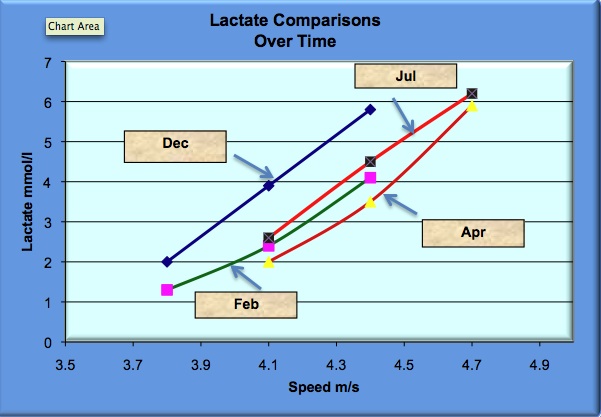
This athlete was preparing for an important competition in August. The tests for December, February and April were indicating a steady progression toward her goal of a good performance in mid August. But this was not to happen. The coach made a major mistake after the April tests and increased not only the percentage of high intensity workouts, but the general level of training intensity for all workouts and volume. The result was a leftward move of the lactate curve in July and a disappointing performance in August. This chart indicates that something went wrong between April and July. In this case it was too much intensity and the coach ignored the plan that produced the six months of successful training.
Below is another example of a very good triathlete and what happened when he ignored the coach’s training recommendations. This was not a case of the coach recommending the wrong workouts but the athlete himself not following the advice.
In December a one-speed swim test was done with this athlete. He swam 400 m in 5:04 and the lactate reading was 3.1 mmol/l. Based on this one swim, the V4 or tV4 was 5:00.7. Though we show two points on this chart, there was only one swim. The second point indicates where a second swim would probably lie if it had been done. The line is based on the analysis of thousands of swim tests performed by Jan Olbrecht.
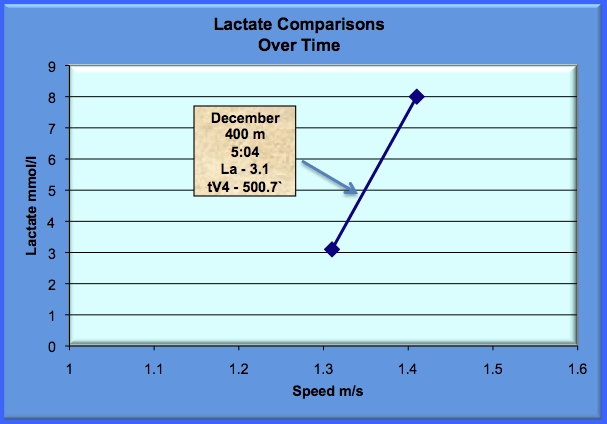
The athlete was given instructions to swim most of his 100 m intervals between 1:15 and 1:17. For 400 m intervals the target time was between 5:15 and 5:25 with most of the yardage closer to 5:25.
What he did was something else. He kept meticulous logs so it was easy to verify what he did. He regularly swam his hundreds close to 1:10 and his 400 m swims around 4:55. His comment was that all these felt easy. But here are the results:
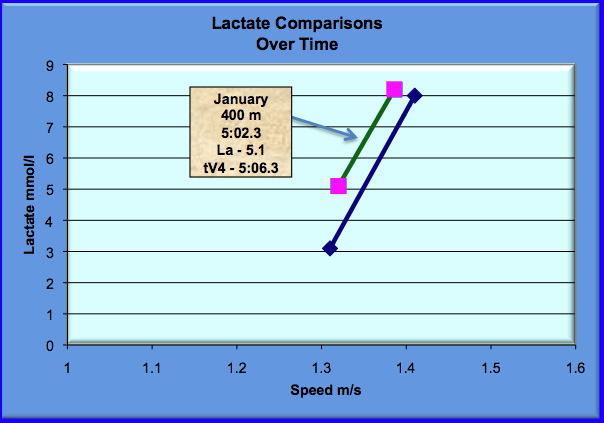
The athlete regressed. He couldn't believe it because his workouts for the previous six weeks felt good, his test felt good. So there must have been a mistake.
But there wasn't. A control test showed he was producing more lactate than expected at all speeds and thus his aerobic capacity had deteriorated. He was given new instructions to swim even slower than had been recommended six weeks previously. His 100 m swims were to be between 1:16 and 1:19 and his 400 m swims were to be between 5:20 and 5:30 with most of the volume near the slower pace. This time he did what was recommended. The results in six weeks were as follows:
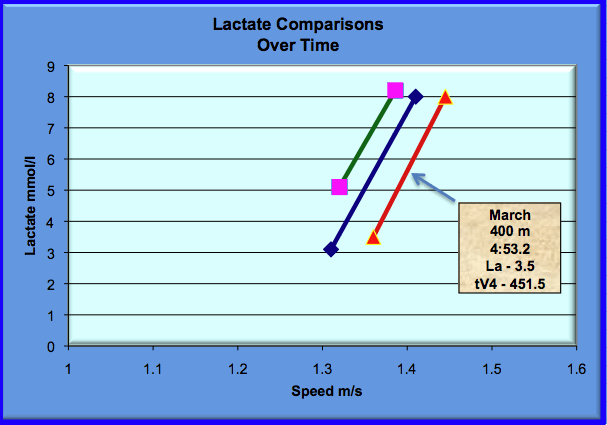
The athlete was faster and he got that way by going slower. Now this approach worked because of the slow speeds, but not all workouts were at slow speeds. A significant amount, about 10% of volume, was at high intensity, substantially above the V4 pace. (We are not recommending here this specific approach because there is not enough information given to execute it properly.) It is intended to show how one can evaluate a training philosophy and see if it is working for the athlete.
The most important use of lactate testing is to evaluate whatever training approach is being used. If the training approach emphasizes high intensity workouts, then lactate testing will tell the coach or athlete if this is working. If the training approach emphasizes long slow distance workouts, then lactate testing will tell the coach or athlete if this is working. If the training approach is based on emails from your favorite guru, then lactate testing will tell the coach or athlete if this is working.
Continue on to Module 13 on how to use lactate testing to set training paces
Module 13 of 19- how to use lactate testing to set and monitor training paces
